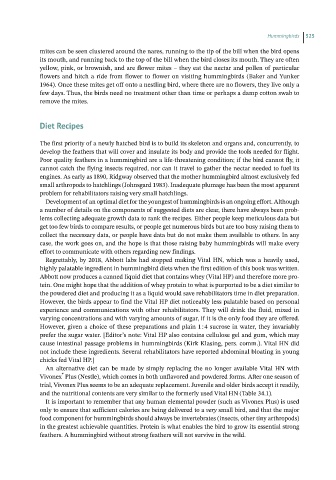Page 527 - Hand rearing birds second
P. 527
Hummingbirds 525
mites can be seen clustered around the nares, running to the tip of the bill when the bird opens
its mouth, and running back to the top of the bill when the bird closes its mouth. They are often
yellow, pink, or brownish, and are flower mites – they eat the nectar and pollen of particular
flowers and hitch a ride from flower to flower on visiting hummingbirds (Baker and Yunker
1964). Once these mites get off onto a nestling bird, where there are no flowers, they live only a
few days. Thus, the birds need no treatment other than time or perhaps a damp cotton swab to
remove the mites.
Diet Recipes
The first priority of a newly hatched bird is to build its skeleton and organs and, concurrently, to
develop the feathers that will cover and insulate its body and provide the tools needed for flight.
Poor quality feathers in a hummingbird are a life‐threatening condition; if the bird cannot fly, it
cannot catch the flying insects required, nor can it travel to gather the nectar needed to fuel its
engines. As early as 1890, Ridgway observed that the mother hummingbird almost exclusively fed
small arthropods to hatchlings (Johnsgard 1983). Inadequate plumage has been the most apparent
problem for rehabilitators raising very small hatchlings.
Development of an optimal diet for the youngest of hummingbirds is an ongoing effort. Although
a number of details on the components of suggested diets are clear, there have always been prob-
lems collecting adequate growth data to rank the recipes. Either people keep meticulous data but
get too few birds to compare results, or people get numerous birds but are too busy raising them to
collect the necessary data, or people have data but do not make them available to others. In any
case, the work goes on, and the hope is that those raising baby hummingbirds will make every
effort to communicate with others regarding new findings.
Regrettably, by 2018, Abbott labs had stopped making Vital HN, which was a heavily used,
highly palatable ingredient in hummingbird diets when the first edition of this book was written.
Abbott now produces a canned liquid diet that contains whey (Vital HP) and therefore more pro-
tein. One might hope that the addition of whey protein to what is purported to be a diet similar to
the powdered diet and producing it as a liquid would save rehabilitators time in diet preparation.
However, the birds appear to find the Vital HP diet noticeably less palatable based on personal
experience and communications with other rehabilitators. They will drink the fluid, mixed in
varying concentrations and with varying amounts of sugar, if it is the only food they are offered.
However, given a choice of these preparations and plain 1 : 4 sucrose in water, they invariably
prefer the sugar water. [Editor’s note: Vital HP also contains cellulose gel and gum, which may
cause intestinal passage problems in hummingbirds (Kirk Klasing, pers. comm.). Vital HN did
not include these ingredients. Several rehabilitators have reported abdominal bloating in young
chicks fed Vital HP.]
An alternative diet can be made by simply replacing the no longer available Vital HN with
®
Vivonex Plus (Nestle), which comes in both unflavored and powdered forms. After one season of
trial, Vivonex Plus seems to be an adequate replacement. Juvenile and older birds accept it readily,
and the nutritional contents are very similar to the formerly used Vital HN (Table 34.1).
It is important to remember that any human elemental powder (such as Vivonex Plus) is used
only to ensure that sufficient calories are being delivered to a very small bird, and that the major
food component for hummingbirds should always be invertebrates (insects, other tiny arthropods)
in the greatest achievable quantities. Protein is what enables the bird to grow its essential strong
feathers. A hummingbird without strong feathers will not survive in the wild.

